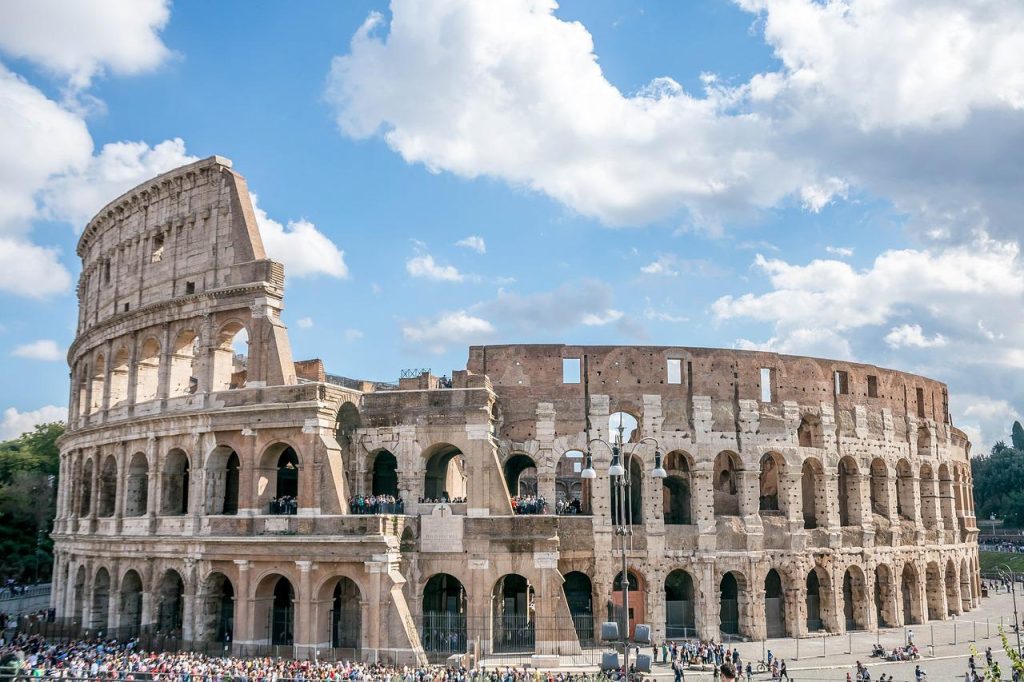The 4 Regions Of Central Italy
Central Italy is divided into four main regions – Tuscany, Umbria, Le Marches, and Lazio. They provide some of the most spectacular scenery in the country including the capital, Rome with its ancient treasures and stunning shopping and ambience.
Summers in these regions are hotter and longer than those of the north, while the winters are much colder inland. The cuisine in Central Italy focuses on meat dishes and leafy vegetables, There is also a rich farming tradition, with many unusual crops grown in the hills or mountains.
I will always remember a magical holiday in a villa deep in the heart of the Tuscany countryside yet within easy reach of the majesty of Florence, the stunning town of Siena, and the iconic city of Pisa with its leaning tower.
There is something quite idyllic about the Italian countryside of Central Italy and when mixed with the tremendous wine and food, you have a little piece of Italian heaven.
Lazio
Lazio is a central Italian region bordering the Tyrrhenian Sea. The capital of the region, and the country, is Rome, the heart of the ancient Roman Empire.
I visited the Eternal City of Rome back in the 1990s and remember it as this big brute of a city but with a huge sprinkling of romance, character, incredible history, and astonishing art! I ticked off all the signature sights including the Colosseum, the Roman Forum, the Pantheon, St Peter’s Basilica, and the Vatican. As you walk the streets and stumble upon sculptures by Michelangelo, paintings by Caravaggio, frescoes by Raphael, and fountains by Bernini you realize that there is nowhere in the world quite like Rome.
With all the sightseeing I found a great place to catch my breath at the famous Trevi fountain. Yes, it’s full of tourists taking pictures (today it’s selfies) and gazing longingly into one another eyes but hey that’s what you do on a city break to Rome….. isn’t it?
I liked a market square called Campo de’ Fiori which is a busy area full of tourists and locals buying everything from fresh fruits, flowers, and vegetables to local olive oil and wine.
For views of the city, it’s hard to beat the Ponte Umberto where you can watch the sunset while admiring the Ponte Sant’Angelo, Castel Sant’Angelo, and the dome of St. Peter’s Basilica.
The Spanish Steps are not far from here and ideal to visit towards the end of the day as the Spagna metro stop is right by them so it’s easy to get back to your hotel or the airport if needed.
In the evening fashionable drinkers descend on the city’s bars and cafes for deep conversation and plenty of Italian choreographed gesticulation and flailing of arms!
Rome is magnificent and huge…. so you need two or three days to do it at your own pace!
Attractions of the Lazio Region
Ostia Antica – an archaeological park.
Pontine Islands – an archipelago of six volcanic islands – Ponza, Palmarola, Zannone, Gavi, Ventotene, and Santo Stefano.
Castel Gandolfo – an area on the Alban hills and the venue of the Pope’s summer residence, noble villas and high-class cuisine.
Civita di Bagnoregio – known as “the Dying City”, is this historic village perched on a hillside and accessible through a pedestrian bridge.
Sperlonga – one of the “Borghi più belli d’Italia” – Italy’s most beautiful villages.
Tarquinia – a town of artists with an extraordinary necropolis, medieval monuments and a nature reserve.
Gardens of Bomarzo – a park with XVI-century basalt sculptures depicting monsters, deities and mythological beings.
Tivoli – a peaceful city outside of Rome with magnificent villas.
National Park of Circeo – a wide UNESCO-protected area along the coast between Anzio and Terracina.

The Marches
This region of Central Italy is well known for its beaches cliffs and caves, backed by hills and mountains popular in the winter for skiing. Ancona is the regional capital.
Ancona is an ancient city founded by the Greeks. Split into two parts – the historic centre on Monte Guasco and the modern part on the coast.
Among its standout monuments is the Cathedral of San Ciriaco, with its white and rose marble façade. The Cathedral dominates the city from the heights of Guasco Hill, where the city’s Acropolis was built.
Attractions of The Marches Region
Senigallia – a seaside resort and popular lido for people-watching.
Gabicce Mare, Pesaro, Fano, Civitanova Marche and San Benedetto del Tronto – fashionable resorts frequented by high society.
Monti Sibillini and Monti Della Laga National Parks – for wildlife and the great outdoors
Conero Riviera offers amazing views and patches of still unspoilt land, often only accessible via the sea or footpaths carved into the green Mediterranean scrub.
The Frasassi Caves – age-old limestone caves.
Piceno and the Esino Valley – An area rich in orchards and vineyards.
Tuscany
Tuscany is perhaps Italy’s most compelling and beautiful region combining natural beauty with heavenly towns and cities. The region’s capital is Florence.
Florence is incredible. As someone who does not embrace the cultural scene in terms of statues of men’s genitalia, broken pots, and museums I have to say Florence delivered it to me on a whole different level!
The palaces, museums, and churches are home to some of the greatest artistic treasures in the world. The most popular and important sites in Florence include the jaw-dropping Basilica of Santa Maria del Fiore, the Baptistery, the Uffizi Gallery, the Bargello and the Accademia. Add to this, the numerous churches, art galleries, and the library of San Lorenzo dedicated to Michelangelo’s architectural genius and you have a city of world renown.
Despite the heavyweight culture, Florence has a small-town feel, with its meandering cobbled streets, tiny boutiques, and eateries. These are great as after a long day sightseeing all you sometimes need is an ice-cold beer and a bowl of pasta! Well, I do anyhow!
If you are looking at spreading out beyond the main centre then why not visit the Boboli Gardens or climb up the hill to the church of San Miniato al Monte for some of the very best views of the area?
Siena – When someone asks me if I have any recommendations for Italy they will, I guess, expect me to suggest the signature cities like Rome, Venice, or Florence but actually, the first name on my lips is always Siena. I spent an afternoon and evening here which is not long enough, back in the late nineties, and was bowled over by the charm and the character of this pretty, small yet atmospheric medieval town. Siena is famous for the Palio – a horse race around the dome shape of Piazza del Campo. I am not keen on this event as I know many horses are injured partaking so once again Italy is generating this love-hate feeling but putting that to one side the rest of the town is incredible.
The Duomo di Siena is one of the standout buildings off the main Piazza as well as the Torre del Mangia which you can climb for amazing views of the town. Every Wednesday, it’s the biggest market Tuscany has to offer, and it’s at La Lizza. The gorgeous little back streets of Siena at dusk are a dream – the sound of scooters and footsteps on cobbled streets as people shop for local leather goods or stock up on fresh fruit, vegetables, cheese, and wine is to them just everyday life but to me its why I travel. Siena is in my opinion, the best of Italy.
Pisa is of course renowned for its leaning tower which is simply magnificent as is the area immediately around it – the Campo Dei Miracoli or the Piazza del Duomois. This is a large, green open space hosting a group of monuments that are famous all over the world – the baptistery, the cathedral, the cemetery, and the world-famous leaning tower. The Piazza has been on UNESCO’s list of World Heritage sites since 1987.
To the southeast of the Campo, on the river, you’ll find the Museo Nazionale di San Matteo, a fine collection of art and sculpture, while west along the Arno is the Palazzo Reale. A strip of unattractive beach resorts stretches north along the coast from near Pisa to the Ligurian border. This Riviera Della Versilia should be something more special, given the dramatic backdrop of the Alpi Apuane, but the beaches share the coastal plain with a railway, autostrada, and roads.
Overall I was disappointed in Pisa – yes the tower is an amazing site but the hordes of tourists taking the money shot backed by stalls selling souvenir books and tacky model leaning towers was not for me…
Attractions of the Tuscany Region
San Gimignano – a beautifully well-preserved medieval town with tall towers and narrow alleys.
Val d’Orcia – a valley of winding slopes dotted with cypresses and vineyards.
Chianti – somewhere you are likely to find me is a naturally beautiful area famous for its wine. Viareggio – a seaside Riviera-style resort known for its carnival.
Lucca – a city on the Serchio river known for its well-preserved Renaissance walls encircling the city centre.
Baratti Gulf – many stunning beaches in the coastal area between Livorno and Grosseto.
Elba Island – with its amazing beaches and clear waters.

Umbria
The region of Umbria comprises mainly hills, mountains, hollows, and plains and extends along the Tiber’s central basin. The region’s capital is Perugia.
Like many Italian towns, Perugia is steeped in history. The centre is on a hilltop and is packed with medieval lanes and fine buildings. Corso Vannucci, the town’s principal street, is pedestrianized and leads to the main square, Piazza IV Novembre. The town’s cathedral, the Duomo or Cattedrale si San Lorenzo has a baroque facade and Roman ruins
Perugia has two major universities, one of which is for foreigners and this has led to a lot of bars and student digs catering to the younger audience and has brought a drinking culture to parts of the town.
Attractions of the Umbria Region
Lake Trasimeno is central Italy’s largest lake.
Castiglione del Lago – ancient dwellings amid a natural landscape.
The Cascate delle Marmore – waterfalls near Terni.
The River Nera – is an area popular for sports lovers who enjoy canoeing, and kayaking.
Carsulae – an ancient Roman town.
The Dunarobba Fossil Forest is an ancient forest that existed 3 million years ago.
Contact Information
For further information on taking a trip to any region of Italy, contact your local travel agent, a specialist tour operator or the Italian National Tourist Office.
If you are considering a trip to the North of Italy then check out my recent Italian Adventure.







